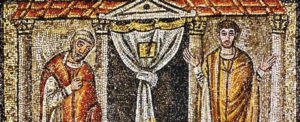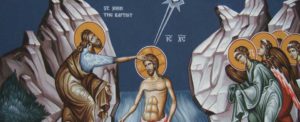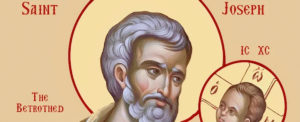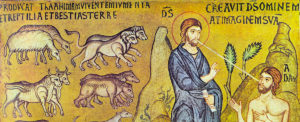On the first Sunday of Great Lent we commemorate the restoration of the icons.
The Sunday of the Triumph of Orthodoxy is the first Sunday of Great Lent. The theme of this Sunday since 843 AD has been that of the victory of the icons. In that year the iconoclastic controversy, which had raged on and off since 726, was finally laid to rest, and icons and their veneration were restored on the first Sunday in Lent. Ever since, this Sunday has been commemorated as the “Triumph of Orthodoxy.”
Historical Background
The Seventh Ecumenical Council dealt with the controversy regarding icons and their place in Orthodox worship. It was convened in Nicaea in 787 by Empress Irene at the request of Tarasios, Patriarch of Constantinople. The Council was attended by 367 bishops.
Almost a century before this, the iconoclastic controversy had once more shaken the foundations of both church and state in the Byzantine empire. Critics claimed that the respect and the miracles attributed to icons by some members of society approached the point of worship, which is due only to God, and amounted to idolatry. This accusation led to excesses at the other extreme by which icons were completely taken out of the liturgical life of the Church by the Iconoclasts (“image-smashers”). The Iconophiles (“image-lovers”), on the other-hand, believed that icons served to preserve the doctrinal teachings of the Church. They considered icons to be man’s dynamic way of expressing the divine through art and beauty.
The Council expressed clearly the doctrine.which the Church had always received and taught: that icons are to be honored and venerated, but not worshipped as gods.
The decree of the Council which restored icons to churches added an important clarification, dealing with the erroneous perception that worship is ever offered to anything other than the Holy Trinity:
We define that the holy icons, whether in color, mosaic, or some other material, should be exhibited in the holy churches of God, on the sacred vessels and liturgical vestments, on the walls, furnishings, and in houses and along the roads, namely the icons of our Lord God and Savior Jesus Christ, that of our Lady the Theotokos, those of the venerable angels and those of all saintly people. Whenever these representations are contemplated, they will cause those who look at them to commemorate and love their prototype. We define also that they are to be be kissed and that they are an object of veneration and honor (timitiki proskynisis), but not of real worship (latreia), which is reserved for Him Who is the subject of our faith and is proper for the divine nature. The veneration accorded to an icon is in effect transmitted to the prototype; he who venerates the icon, venerated in it the reality for which it stands.
A regional council was called in Constantinople in 843 under Empress Theodora. The veneration of icons was solemnly proclaimed at the Hagia Sophia Cathedral. The empress, her son Emperor Michael III, Patriarch Methodios, and monks and clergy came in procession and restored the icons in their rightful place. The day was called “Triumph of Orthodoxy.” Since that time, this event is commemorated yearly with a special service on the first Sunday of Lent.
Orthodox teaching about icons, as defined at the Seventh Ecumenical Council of 787, is embodied in the texts sung on this Sunday.
From Vespers:
Inspired by your Spirit, Lord, the prophets foretold your birth as a child incarnate of the Virgin. Nothing can contain or hold you; before the morning star you shone forth eternally from the spiritual womb of the Father. Yet you were to become like us and be seen by those on earth. At the prayers of your prophets in your mercy count us worthy to see your light, for we praise your resurrection, which holy and beyond describing. Infinite Lord, as God, in the last days you have willed to become incarnate and finite; for when you took on flesh you made all its properties your own. Therefore we depict the form of your outward appearance and pay it relative respect, and so we are moved to love you; and through it we receive the grace of healing, following the divine traditions of the apostles.
The grace of truth has shone forth: the things once foreshadowed now are revealed in perfection. See, the Church is decked with the embodied image of Christ, as with beauty not of this world, fulfilling the tabernacle of witness, holding fast the Orthodox faith. For if we cling to the icon of him whom we worship, we shall not go astray. May those who refuse to so believe be covered with shame. For the image of him who became human is our glory: we venerate it, but do not worship it as God. Kissing it, we who believe cry out: O God, save your people, and bless your inheritance.
We have moved forward from unbelief to true faith, and have been enlightened by the light of knowledge. Let us then clap our hands like the psalmist, and offer praise and thanksgiving to God. And let us honor and venerate the holy icons of Christ, of his most pure Mother, and of all the saints, depicted on walls, panels and sacred vessels, setting aside the unbelievers’ ungodly teaching. For the veneration given to the icon passes over, as Basil says, to its prototype. At the intercession of your spotless Mother, O Christ, and of all the saints, we pray you to grant us your great mercy. We venerate your icon, good Lord, asking forgiveness of our sins, O Christ our God. For you freely willed in the flesh to ascend the cross, to rescue from slavery to the enemy those whom you had formed. So we cry to you with thanksgiving: You have filled all things with joy, our Savior, by coming to save the world.
The name of this Sunday reflects the great significance which icons possess for the Orthodox Church. They are not optional devotional extras, but an integral part of Orthodox faith and devotion. They are a necessary consequence of Christian faith in the incarnation of the Word of God, the second Person of the Trinity, Jesus Christ. They make present to the believer the person or event depicted on them. This is why the interior of Orthodox churches is covered with icons painted on walls and domed roofs, and there is always an icon screen, or iconostasis, separating the altar from the nave, often with several rows of icons. No Orthodox home is complete without an icon corner, where the family prays.
Icons are venerated by lighting lamps and candles in front of them, by the use of incense and by kissing. But there is a clear doctrinal distinction between the veneration of icons and the sacramental worship offered to God. Veneration is given to the person represented by the icon. This distinction safeguards the veneration of icons from any charge of idolatry.
The theme of the victory of the icons, by its emphasis on the incarnation, points us to the basic Christian truth that the One whose death and resurrection we celebrate at Pascha was none other than God the Word who became human.
From the Synodikon, the decision of the Seventh Ecumenical Council:
As the prophets beheld, as the Apostles have taught, as the Church has received, as the teachers have dogmatized, as the universe has agreed, as grace has illumined, as truth has revealed, as falsehood has been dispelled, as wisdom has presented, as Christ has triumphed: This we believe, this we declare, this we preach:
Christ our true God, and His saints we honor in words, in writings, in thoughts, in sacrifices, in temples, in icons, on the one hand bowing down and worshipping Christ as God and Master, on the other hand honoring the saints as true servants of the Master of all, and offering to them due veneration.
This is the faith of the Apostles! This is the faith of the Fathers! This is the faith of the Orthodox! This is the faith that has established the Universe!
Therefore, with fraternal and filial love, we praise the heralds of the faith, those who with glory and honor have struggled for the faith, and we say: For the champions of Orthodoxy, faithful emperors, most-holy patriarchs, hierarchs, teachers, martyrs, and confessors: May their memory be eternal!
Before the Triumph of Orthodoxy came to be celebrated on the first Sunday of Lent, there was on this day a commemoration of Moses, Aaron, Samuel and the prophets. Traces of this more ancient observance can still be seen in the choice of the Epistle reading at the Liturgy and in the Alleluia verse appointed before the Gospel: “Moses and Aaron among His priests, and Samuel among them that call upon His Name.”






